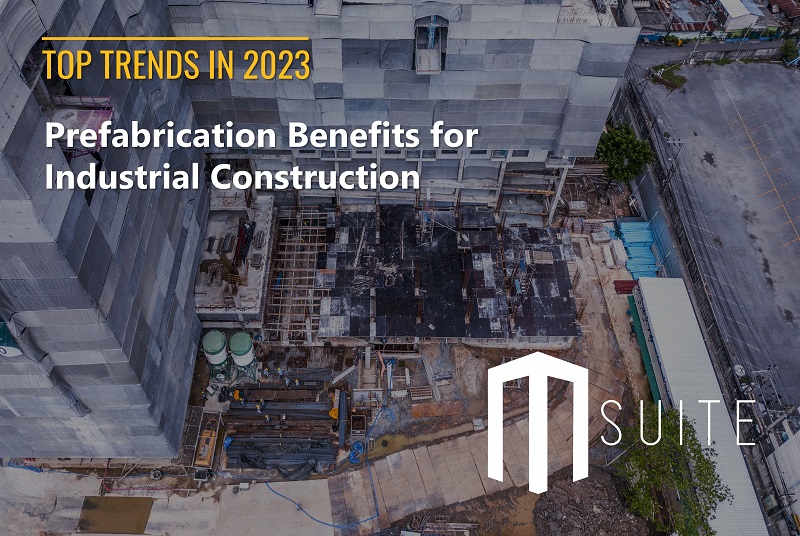Industrial construction is a growing sector within prefabrication. While previously done on-site, industrial contractors are moving to safer, off-site facilities that come with a variety of benefits.
Industrial construction is primarily located on the outskirts of a town. Therefore, manufacturing sites factor in the need for special conveyance requirements such as 24/7 shipping and receiving, accessible nearby air or railroad transportation, or access to major highways.
A building design for industrial structures revolves around floor plans that promote smooth foot traffic and focus on coordinating manufacturing and distribution. These buildings are constructed for functionality, not style, and are designed to support equipment built to meet industry-specific regulations.
Industrial projects go through permitting and occupancy requirements to satisfy local entities, just like commercial projects. Still, these larger industrial projects must meet permitting requirements that comply with many different exacting standards from local, state, and federal agencies.
Contractors are pioneering prefabrication and industrialized construction processes around the globe. Contractors redefine prefabrication standards and practices from the pharmaceutical, healthcare, and higher U.S. education markets with each successful project. Using innovative and integrated technologies such as MSUITE, DADO, PypeServer, and many others, processes such as BIM, material and asset tracking, and just-in-time delivery are helping industrial project teams succeed. The goal of industrialization combined with innovative technology helps shorten construction project schedules, reduce waste, improve worker safety, and increase economic outcomes.
Prefabrication’s Approach to Industrial Projects
Traditionally, prefabrication in the construction industry meant that a single manufacturer or trade contractor (single trade) creates and assembles building components offsite and then delivers them for installation on the jobsite. This is a typical process on many projects. However, the “multi-trade” prefabrication process builds on this concept in a few ways. First, components can be assembled locally near a trade-managed facility onsite or close to the jobsite. This process integrates work performed by multiple trades and involves complex assemblies. As a result, multiple trade contractors can consistently provide the schedule and cost benefits of prefabrication to accelerate projects irrespective of geographic area.
Prefabrication versus Modular Construction
Although often interchanged, prefab and modular construction processes have distinct differences. While prefabrication is an all-encompassing term, modular construction describes one category of prefabricated construction. Think of tissues; not all are Kleenexes, but all are tissues.
Modular construction takes prefab a few steps further. It often includes elements like plumbing and electrical work–completed beforehand and delivered to the construction site. While modular construction can save time, energy, and money, it is difficult to change course or leave space for wiggle room once the project begins.
Using Lean Methods with Prefabrication on Industrial Projects
Industrialization on the construction site goes beyond prefabrication alone and is symbiotic with Lean Construction. Employing processes such as kit-packing, pre-assembly, and Just-in-Time (JIT) delivery reduces operational inefficiencies driven by excess material movement, absence of resources, and time waiting for materials. Each project is unique, but leading contractors have created custom prefabrication and industrialized approaches over the past years.
Benefits of Prefabrication on Industrial Projects:
- Reduced schedule – Offsite fabrication allows us to initiate work on interior assemblies much earlier in the construction sequence with greater efficiency, leading to accelerated project schedules.
- Enhanced quality – Prefabrication allows the construction of building components in a climate-controlled, well-lit, clean environment. It will enable teams to control production and streamline the work among trades. Compared to traditional jobsite construction, a controlled offsite facility offers better quality and no downtime due to weather or material shortages.
- Improved safety –Typical overhead work is performed at bench height in well-lit and ventilated conditions. Workers have ample room to move around modules to install ceiling elements rather than working off ladders.
- Minimized waste – Scrap is substantially reduced because materials can be ordered to exact lengths and in correct amounts, resulting in fewer mistakes, misalignments, and deviations.
- Reduced Environmental Impact – Offsite construction reduces pollution and less disturbance at jobsites. The controlled dry environment of a factory reduces water use and promotes the recycling of materials and other scraps. Plus, less onsite traffic and streamlined transportation minimize fossil fuel use.
- Financial value – Prefab and industrialization enable accelerated schedules that deliver projects earlier, lowering overhead project costs and accelerating operating revenue generation to begin sooner.
- Improved maintainability – The uniformity of modules and prefabricated materials means lower maintenance and operating costs.
- Increased local participation – Local subcontractors assemble, transport, and install assembled components, ensuring code compliance and resulting in more dollars spent in the local community.
Whether your next project requires industrial or commercial construction capabilities, MSUITE empowers contractors to increase productivity between design, fabrication, and field teams working on industrial construction projects.







